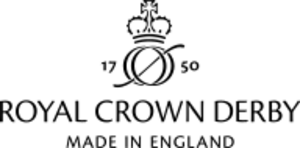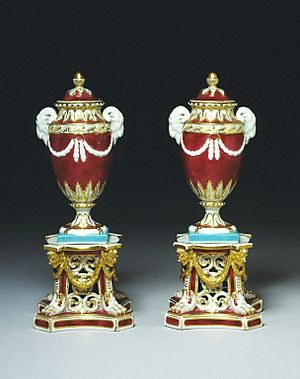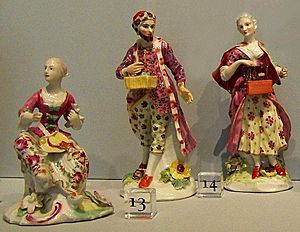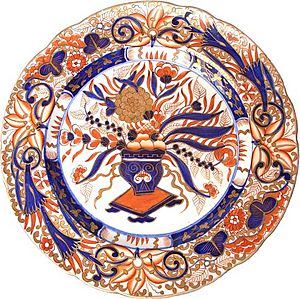Royal Crown Derby facts for kids
 |
|
|
Trade name
|
Royal Crown Derby |
|---|---|
| Private limited company | |
| Industry | Pottery |
| Founded | Approximately 1750 |
| Headquarters | , |
|
Key people
|
Kevin Oakes (CEO) |
| Products | Porcelain ceramics |
| Owner | Oakes family |
Royal Crown Derby is one of England's oldest porcelain makers. It started around 1750 in Derby, England. The company is famous for its beautiful and high-quality bone china, which is a type of porcelain. They make fancy tableware (like plates and cups) and decorative items.
The company was first called 'Derby Porcelain'. In 1773, it became 'Crown Derby'. Later, in 1890, it was given the special 'Royal' name, making it 'Royal Crown Derby'.
Contents
History of Royal Crown Derby
How the Company Started
The story of Royal Crown Derby began with a man named André Planché. He was an immigrant from Saxony who settled in Derby. Between 1747 and 1755, he made porcelain vases and figures.
In 1756, Planché teamed up with William Duesbury (1725–1786). Duesbury was a skilled porcelain painter. They also partnered with a banker named John Heath. This partnership officially started the Derby company. However, some porcelain was already being made at their workshop in Cockpit Hill as early as 1750.
André Planché left the business early on. William Duesbury and John Heath continued the company. Later, Duesbury ran it by himself.
William Duesbury's Success
William Duesbury was a very talented businessman. He created a new type of porcelain that was very strong and beautiful. This allowed the factory to make high-quality tableware. He quickly made Derby a top maker of dinner sets and figures. He hired the best artists for painting and sculpting.
In 1770, Duesbury bought the famous Chelsea porcelain factory in London. He moved its valuable items, like molds and patterns, and many workers to Derby. In 1776, he also bought parts of the Bow porcelain factory.
In 1773, King George III was so impressed with Duesbury's work that he allowed the company to use the royal crown in its mark. This is when the company became known as 'Crown Derby'.
New Leaders and Challenges
When William Duesbury died in 1786, his son, William Duesbury II (1763–1796), took over. He was also a skilled leader and kept the company's good reputation. He also created new glazes and types of porcelain.
Sadly, William Duesbury II died young in 1797. His business partner, Michael Kean, then took charge. Many skilled artists left during this time. However, some great artists, like William Pegg, continued to create beautiful work. William Pegg was known for his unique flower paintings. The company faced financial difficulties during Kean's time.
William Duesbury III, son of William Duesbury II, eventually took over the factory.
Robert Bloor's Time
In 1815, a salesman named Robert Bloor leased the factory. The Duesbury family was no longer involved. Bloor borrowed a lot of money to run the business. He was a very smart businessman and helped the company become financially strong again.
Under Bloor, the company made very colorful and elegant porcelain. They were especially known for their bright Japanese Imari patterns. These designs had detailed geometric shapes and flower patterns. These designs were very popular and helped Derby succeed.
However, Robert Bloor died in 1845. After a few years, the original factory closed in 1848.
Keeping the Tradition Alive
After the factory closed, a group of former employees started a new factory in King Street, Derby. They continued to use the old molds and patterns. This kept the Derby tradition of fine craftsmanship alive. They even used the original potter's wheel from the Duesbury family!
The Modern Era Begins
In 1877, new owners built an impressive factory on Osmaston Road in Derby. This marked the start of the modern period for Derby porcelain. Crown Derby's designs became very popular in the late Victorian era. Their fancy and romantic styles were exactly what people liked.
Becoming "Royal"
In 1890, Queen Victoria gave Crown Derby a special honor. She named them "Manufacturers of porcelain to Her Majesty." She also granted them the title "The Royal Crown Derby Porcelain Company." This is how they got the "Royal" in their name.
In 1935, Royal Crown Derby bought the King Street factory. This brought the two parts of the business back together.
Recent History
In 1964, a larger company bought Royal Crown Derby. It became part of a bigger group of pottery companies.
In 2000, a former director named Hugh Gibson led a buy-out. This made Royal Crown Derby an independent company again. In 2006, about 300 people worked at the Osmaston Road factory.
In 2013, Hugh Gibson retired and sold the company to Steelite International. The Derby factory and visitor center are still open. Steelite International plans to make Royal Crown Derby tableware for hotels and restaurants around the world.
In 2016, Kevin Oakes, who used to be the chief executive of both Crown Derby and Steelite, bought the company.
Royal Crown Derby Visitor Centre
The Royal Crown Derby Visitor Centre in Derby is a great place to visit. It has a museum with many beautiful porcelain items. You can also take tours of the factory to see how the porcelain is made. There's also a gift shop and a restaurant.
Images for kids
-
A Biscuit tin shaped like stacked Derby porcelain plates, made in 1906.
See also
 In Spanish: Royal Crown Derby para niños
In Spanish: Royal Crown Derby para niños
- John Haslem (1808–1884), a talented china painter who worked at the factory. He also wrote a book about the factory's history.







